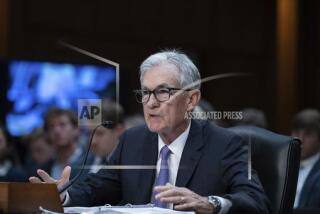Doubts Key Part of Deficit Plan, Fed Chief Says
- Share via
WASHINGTON — Federal Reserve Board Chairman Alan Greenspan, questioning what is expected to be a key element of the Bush Administration’s deficit-reduction plan, said Tuesday that he does not believe interest rates will drop sharply this year.
When asked whether it is realistic for the Administration to rely on a forecast that short-term interest rates will fall at least 2 percentage points from current levels while the economy maintains its healthy growth rate, Greenspan told the Joint Economic Committee: “Technically . . . it is feasible. Is it probable? No, it is not.”
Counting on Lower Rates
The Administration is counting on declining interest rates to slice $9 billion from the deficit next year by reducing interest payments on the national debt.
Despite the dispute on interest rates, Greenspan went out of his way to play down reports that he and President Bush disagree significantly on economic policy. Last week, after Greenspan said that the Fed would maintain relatively high interest rates to help curb inflation, Bush told reporters that he did not want the Fed to “move so strongly against fear of inflation that we impede growth.”
“There is far less here than meets the eye,” Greenspan contended. Whatever differences exist between the Fed and the Administration, he said, “are quite minuscule.”
But Greenspan’s doubts about the economic assumptions underlying the Administration’s budget blueprint are sure to keep the controversy alive.
White House Budget Director Richard G. Darman has indicated that the Bush Administration plans to rely on the Ronald Reagan Administration’s economic forecast in developing its own budget proposals, primarily because it has no time to prepare an alternative before Bush’s scheduled Feb. 9 economic policy speech to Congress.
Facing Automatic Cuts
Under the Gramm-Rudman deficit law, Congress and the White House are required to reach agreement on a budget plan that would reduce the deficit to $110 billion for the fiscal year that begins on Oct. 1. Failure would result in automatic, nearly across-the-board spending cuts mandated by the deficit-reduction law.
If there are no changes in current spending and tax policies, the Reagan Administration predicted, the deficit will reach $127 billion next year. It called for a variety of measures that it said would reduce the deficit to $92 billion.
To produce those deficit estimates, Reagan’s budget forecasts that the economy will grow by 3.2% this year and that 91-day Treasury bills will pay an average of 6.3% interest during 1989, sharply lower than the current level of 8.3%. The Administration also counted on a drop in long-term interest rates to an average of 8.3% from the current rate of about 9%.
However, most analysts do not believe interest rates can fall significantly unless the economy’s growth slows from its current pace of about 3%.
Of course, lower growth depresses tax revenues, and the deficit would probably rise more as a consequence of that than it would fall as a result of declining interest rates.
“The prospect of slower economic growth to curtail inflation could provoke a confrontation between the Federal Reserve and the Bush Administration later this year,” David Hale, chief economist at Kemper Financial Services in Chicago, contended. “If economic forecasts are revised to incorporate projections of only 2.5% growth with T-bill yields of 8% to 9%, federal deficit estimates could easily rise into the $160-billion to $180-billion range.”
Because the federal government pays interest on more than $2.6 trillion in existing debt, interest rates that exceed projected levels would add significantly to federal interest costs, estimated at about $165 billion this year.
Even with its projection of falling interest rates, the Administration forecasts that interest payments will rise to $170.1 billion next year because of increases in the amount of outstanding debt.
If interest rates average just 2 percentage points higher than expected in 1989, interest payments would jump an additional $9 billion.
If a rise in interest rates were accompanied by an increased inflation rate, that would help with the deficit by generating additional government revenues. But Greenspan sought to throw cold water on that possibility as well, repeating last week’s testimony that the Fed remains determined to reduce inflation from current levels.
Nonetheless, Greenspan said, the Fed and the Administration remain in close contact on economic policy matters. Greenspan repeated his backing for Bush’s plan to rely primarily on spending cuts to reduce the deficit and offered support for Bush’s controversial proposal to reduce the capital gains tax rate on investment profits.
Greenspan said he had met with Bush in December and that he speaks with Treasury Secretary Nicholas F. Brady “on a continuous basis. . . . I have no concern about the issue of communication with President Bush.”
More to Read
Get the L.A. Times Politics newsletter
Deeply reported insights into legislation, politics and policy from Sacramento, Washington and beyond. In your inbox three times per week.
You may occasionally receive promotional content from the Los Angeles Times.










